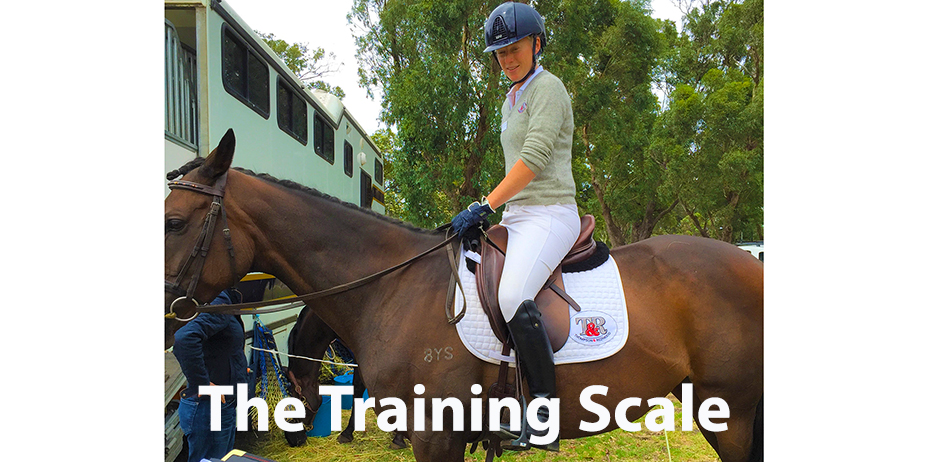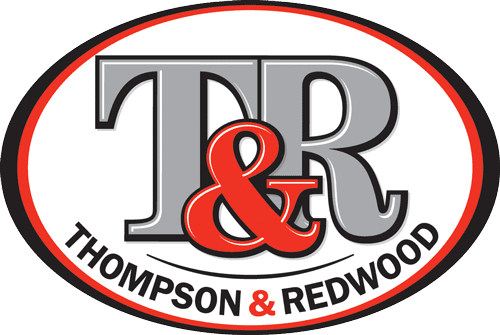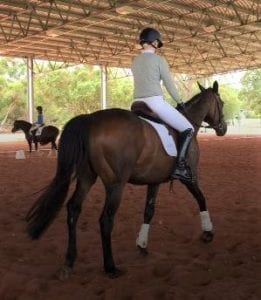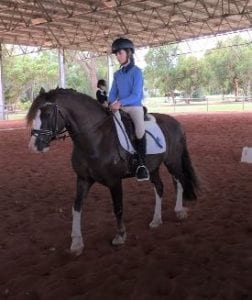
08 Mar The Training Scale – Sustainable Equitation
Our sponsored eventing rider Sophie Warren and co-founder of Sustainable Equitation, Portland Jones, recently took part in a demonstration at the PCAWA State Coaching School. Here, they talked about how the equitation science training scale works, and gave a demonstration of each stage of the scale. Here is a snippet of some of the content they delivered – a useful insight for those wishing to learn more about horse training!
“All good training systems start with reliable, single responses. These responses, which can be assessed easily and objectively, form the foundation for further training. In some sports, these responses are formed into drills (such as in gymnastics or martial arts) or they are static positions (such as in ballet). And, of course, not all training is focused on sport – the modern way of teaching language skills is through phonics. This method teaches children to recognise basic units of language (phonemes) and combine them to form words and sentences. Again, clear and replicable basic units of behaviour that can be objectively identified.
When we train horses our fundamental goal is to control the horse’s line and speed initially and then also his outline. Once we can do this we can do pretty much anything that we need to do with the horse. The horse’s line, rhythm and outline should, for reasons of safety and for optimal welfare, be controlled with light signals and be produced reliably and immediately. This is because science has shown that delayed and heavy signals are often a significant contributor to tension and problem behaviours such as bucking and rearing.
The German Training Scale doesn’t privilege the immediacy and lightness of the basic responses and neither does it provide objective criteria for judging the development of these responses in the ridden horse. If it did, the scale would be embedded into the judging of dressage tests and the judging system would not struggle to find a way to adequately renumerate correctly trained marginal breeds such as standardbreds.
Renowned equine behaviourist, Dr Andrew McLean, developed the Equitation Science training scale to offer clear guidelines for training responses both in hand and under saddle. The scale informs the training, not just of basic responses, but also more advanced dressage movements and other behaviours such as float loading and jumping. When implemented systematically, the ES training scale has the potential to markedly improve rider safety by reducing training conflicts and improving the welfare of the ridden horse.
The Equitation Science Scale
Basic attempt
The rider or handler has a basic degree of control over the horse’s foundation responses: go, stop, turn and (eventually) yield. At this level the responses may be heavy, delayed, inconsistent – or all three! The foundation responses are responsible for controlling the legs of the horse – for horses at this stage longitudinal flexion (aka “roundness” or outline) are unimportant.
Obedience
The rider or handler can achieve these responses immediately and with a light signal. Once this level of training is achieved the horse is much safer as he is not likely to be stressed by overly heavy pressure.
In pony club or ARC situations horses that haven’t achieved obedience level should managed very carefully during jumping lessons or on the cross country course. It is far safer to establish light signals than to use heavy pressures to control the horse in an exciting setting.
Rhythm
The horse maintains a designated speed and tempo. This is self-carriage, the horse maintains his rhythm without the need for constant signals from the rider’s legs or hands.
At this level, the rider can start to differentiate between shorter vs slower and longer vs quicker.
Straightness
The horse maintains a designated line. The drifting and asymmetry that are a function of four-legged locomotion are largely eliminated. The horse stays straight through his body.
Contact
The connection with the rein remains constant and light. This allows for very subtle communication – the pressures used by this level should be extremely light. This is the level at which the function of the seat and weight aids become more useful.
The ES training scale can be used as a guide in the training of all behaviours – in hand and under saddle. It applies to jumping as well.
Most problem behaviours occur at basic attempt and obedience level. Once this level of training has been mastered the horse is a great deal safer to lead and ride. Loss of obedience in a trained horse should be addressed immediately as it suggests the training is incorrect.
The training scale offers a really useful insight into the development of longitudinal flexion (also known as roundness or outline) because it suggests that until the horse is light, obedient, straight and in self-carriage, a contact (the precursor to longitudinal flexion) is unlikely to occur organically. That is, if the horse is disobedient, heavy to the signals, not maintaining rhythm or crooked yet has longitudinal flexion, it has most likely been achieved through an incorrect and possibly heavy rein contact.”





Lee
Posted at 02:28h, 28 AprilGreat advise, although many years experience going back to ride and educate a young horse it’s amazing how much you forget or take for granted with your other educated horses thankyou will go back and rethink where I’m going wrong
Lee
Posted at 02:32h, 28 AprilThankyou for your advice it’s amazing even if you have ridden for many years at a high level how you forget somethings when you start working a uneducated horse and also realise how far you have come and take for granted your educated horses